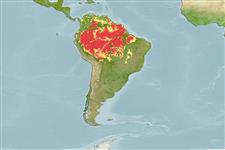Classification / Names
Common names | Synonyms | Catalog of Fishes (gen., sp.) | ITIS | CoL | WoRMS | Cloffa
Actinopterygii (ray-finned fishes) >
Perciformes (Perch-likes) >
Cichlidae (Cichlids) > Cichlasomatinae
Etymology: Aequidens: Latin, aequus, equal, equally + Latin, dens, dentis = teeth (Ref. 45335).
Environment / Climate / Range
Ecology
Freshwater; benthopelagic; pH range: 4.9 - 7.5; dH range: 1 - 13.5. Tropical; 24°C - 26°C (Ref. 1672), preferred ?
South America: widely distributed in the Amazon River basin in Peru, Colombia, Ecuador, Brazil and Bolivia. Also in the Tocantins and Parnaíba rivers, French Guiana, Suriname, Guyana, and in the Orinoco River basin of Venezuela and Colombia.
Size / Weight / Age
Maturity: Lm ? range ? - ? cm
Max length : 16.2 cm SL male/unsexed; (Ref. 36377)
One of the most colorful species of the genus, especially during its reproductive period. Frequently occurs in zones with little current and over a substrate covered with vegetal debris (Ref. 27188). Caught frequently but not abundantly in most varied biotopes- in small creeks and flooded zones with clear, shallow and slow flowing water. Feeds primarily on insects, secondarily on fishes and plants. Very territorial. During reproduction, males attain a deeper coloration. About 1,000 eggs are released during spawning. Spawning takes place on stone or wood. Parents take care of juveniles (Ref. 35237). Maximum length 25 cm TL (Ref. 1672).
Life cycle and mating behavior
Maturity | Reproduction | Spawning | Eggs | Fecundity | Larvae
Produces a minimum of 1000 eggs (Ref. 1672).
Kullander, S.O. and H. Nijssen, 1989. The cichlids of Surinam: Teleostei, Labroidei. E.J. Brill, Leiden, The Netherlands. 256 p. (Ref. 26372)
IUCN Red List Status (Ref. 115185)
CITES (Ref. 94142)
Not Evaluated
Threat to humans
Harmless
Human uses
Fisheries: minor commercial; aquarium: commercial
More information
ReferencesAquacultureAquaculture profileStrainsGeneticsAllele frequenciesHeritabilityDiseasesProcessingMass conversion
Tools
Special reports
Download XML
Internet sources
